Hysterectomy
A hysterectomy is an operation to remove a woman's uterus.
Socioeconomic differentials in hysterectomy in India:
About 3 % of women aged 30–34 reported having undergone a hysterectomy; this proportion increased to 5 % among women aged 35–49, 8 % among women aged 40–44, and to 11% among women aged 45–49. The risk of hysterectomy was higher among women with no schooling.
A woman may have a hysterectomy for different reasons, including:
- Uterine fibroids that cause pain, bleeding, or other problems
- Uterine prolapse, which is a sliding of the uterus from its normal position into the vaginal canal
- Cancer of the uterus, cervix, or ovaries
- Endometriosis
- Abnormal vaginal bleeding
- Chronic pelvic pain
- Adenomyosis, or a thickening of the uterus
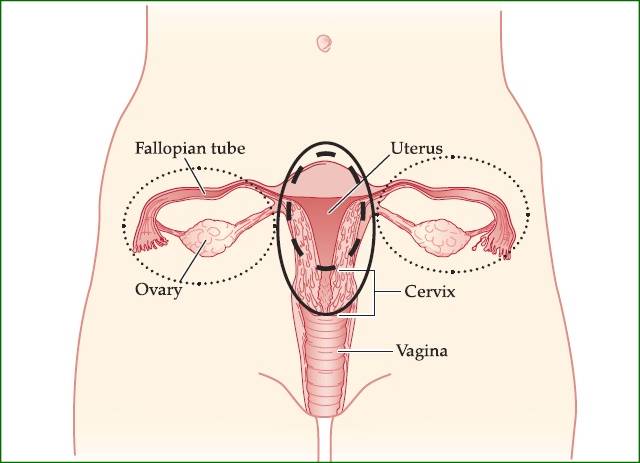
Hysterectomy for noncancerous reasons is usually considered only after all other treatment approaches have been tried without success.
What happens to your body when you have a Hysterectomy?
Hysterectomy removes the uterus and the cervix. This procedure leaves the ovaries intact, and should not induce menopause. Menopause begins when the ovaries are removed or when they no longer produce estrogen. ... Hysterectomy with bilateral salpingo-oopherectomy, removes uterus, cervix and the ovaries.
Types of Hysterectomy
The types of hysterectomy, depending on which structures or organs are removed.
As a general rule, before any type of hysterectomy, women should have the following tests in order to select the optimal procedure:
- Complete pelvic exam including manually examining the ovaries and uterus.
- Up-to-date Pap smear.
- Pelvic ultrasound may be appropriate, depending on what the physician finds on examination.
- A decision regarding whether or not to remove the ovaries at the time of hysterectomy.
- A complete blood count and an attempt to correct anemia if possible.
Types of hysterectomy :
- Total abdominal hysterectomy
- Vaginal hysterectomy
- Laparoscopy-assisted vaginal hysterectomy
- Supracervical hysterectomy
- Laparoscopic supracervical hysterectomy
- Radical hysterectomy
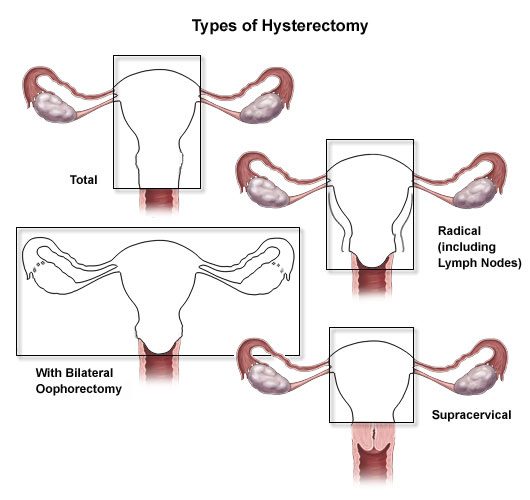
1) Total abdominal hysterectomy, the most common type
The total abdominal hysterectomy is the most common type of hysterectomy. During a total abdominal hysterectomy, the doctor removes the uterus, including the cervix. The scar on the abdomen may be horizontal or vertical, depending on the reason the procedure is performed, and the size of the area being treated.
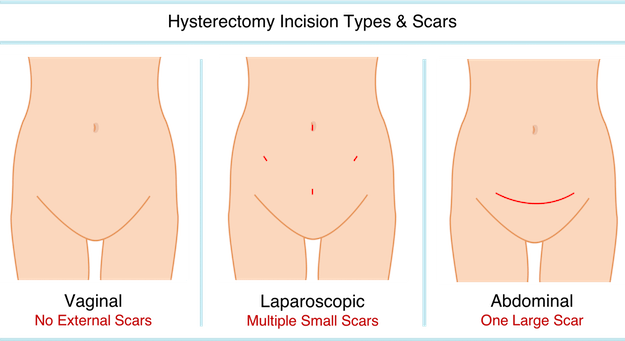
Scar from incision
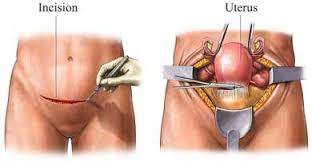
Abdominal Hysterectomy
2) Vaginal hysterectomy procedure :
During this procedure, the uterus is removed through the vagina. A vaginal hysterectomy is appropriate for conditions such as uterine prolapse, endometrial hyperplasia, or cervical dysplasia.
3) Laparoscopy-assisted vaginal hysterectomy/ Total Laparoscopic Hysterectomy
Laparoscopy-assisted vaginal hysterectomy (LAVH) is similar to the vaginal hysterectomy procedure described above, but it adds the use of a laparoscope. A laparoscope is a very thin viewing tube used to visualize structures within the abdomen.
3) Laparoscopy-assisted vaginal hysterectomy/ Total Laparoscopic Hysterectomy
Laparoscopy-assisted vaginal hysterectomy (LAVH) is similar to the vaginal hysterectomy procedure described above, but it adds the use of a laparoscope. A laparoscope is a very thin viewing tube used to visualize structures within the abdomen.
In Total Laparoscopic
Hysterectomy ,entire surgery is done through abdominal tiny ports
Procedure
The procedure is done under general anaesthesia in the operating room. A small incision is made just below your umbilicus. The abdomen is inflated with gas and a fibre-optic instrument called laparoscope is inserted to view the internal organs. Further small incisions may be made on your abdomen through which tiny surgical instruments are passed. Then uterus and cervix are removed along with or without both ovaries and tubes.
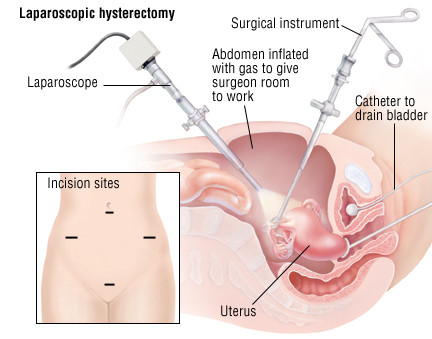
4) Supracervical hysterectomy
A supracervical hysterectomy is used to remove the uterus while sparing the cervix, leaving it as a "stump."
5) Laparoscopic supracervical hysterectomy
The laparoscopic supra cervical hysterectomy procedure is performed like the LAVH procedure, but the uterus is separated from the cervix, and the uterine tissue is removed through the laparoscopic incision. Recovery is generally faster than with other types of hysterectomy.
6) Radical hysterectomy
The radical hysterectomy procedure involves more extensive surgery than a total abdominal hysterectomy because it also includes removing tissues surrounding the uterus and removal of the upper vagina. Radical hysterectomy is most commonly performed for early cervical cancer.
Complications of a hysterectomy include:
- Infection
- Pain
- Bleeding in the surgical area.
An abdominal hysterectomy has a higher rate of post-operative infection and pain than does a vaginal hysterectomy.
What are the alternatives to a hysterectomy?
A hysterectomy for conditions other than cancer generally are not considered until after other less invasive treatments are unsuccessful.
Newer procedures, for example,
- Uterine artery embolization
- Surgical removal of a portion of the uterus (myomectomy), are being used to treat excessive uterine bleeding
- Endometrial ablation and
- Newer medications ( Mifepristone, Ulipristal acetate, GNRH, Dinogest)
- Progesterone IUCD
Long-term effects of hysterectomy on the pelvic floor that should be considered in surgical decision-making are: pelvic organ prolapse, urinary incontinence, bowel dysfunction, sexual function and pelvic organ fistula formation.
Most of the psychological side effects can be completely averted with good counselling session prior to surgery
Life after a hysterectomy:
You'll no longer have menstrual periods. Most of the time, you'll get relief from the symptoms that made your surgery necessary. You won't be able to become pregnant. If you're premenopausal, having your ovaries removed along with a hysterectomy starts menopause
Common Myth in India :
U will feel asexual and lose libido
Mind you any organ loss is mentally traumatic that is why you need to understand the need or indication of it. We encourage our patients to resume their sexual life once they heal ( approx 6 to 8 weeks post surgery)
There will be an empty space in the abdomen
Abdomen also has other viscera and 6 mtrs small intestine .It is like taking a vegetable from a basket so no space remains empty.
I will become fat and have backache
- The care post surgeries are changing.
- We usually ambulate our patient within 24 hours of surgery. So right after discharge they can cater to their own basic needs ( Going to toilet, have meals)
- We refrain from junk food and begin stretching, walking and deep breathing at the earliest
- Proper exercising ,outdoor workout , gym can be started once the healing is proper ( approx 6 to 8 weeks )
Weakness will be permanent
We do a pre surgery workup for all patients so accordingly we can prescribe medicines to correct the deficiency (oral iron and proteins for anemia, calcium for osteoporosis)
All white discharge can lead to cancer
This is sad but the rate of forced hysterectomy is high in uneducated class . With good screening and counselling this can be averted.
OPD Timings
Dr. Mandar R Gadgil
| Mon – Fri | - | 4:30 PM - 7:30 PM w.e.f. 27th August 2022 |
| Saturday | - | 10:00 AM - 11:30 AM |
OPD Timings
Dr. Maithilee Gadgil
| MON – SAT | - | 10:00 AM - 12:30 PM |
| MON – FRI | - | 4:30 PM - 07:00 PM w.e.f. 27th August 2022 |
Any Question Or Query
Feel free to ask for your any Question or Query /
Book An Appointment
Appointment
To book appointment call us on

